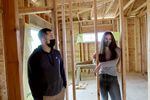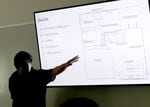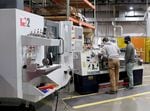On one side of Apollo Avenue in Northeast Salem, there’s a whole row of houses. On the other side of the street, there’s a house mid-construction next to an empty lot.
The partially-built house is the work of students in the residential construction program at the Career Technical Education Center, or CTEC, operated through the Salem-Keizer Public Schools.
Instead of the usual homebuilding crew of three professionals, there are about 20 students building the house, with supervision from instructors.
The house is based on a graduate’s design from the year before. The empty lot next door will soon be another house, also designed and built by CTEC students.

CTEC students are building this house on Apollo Ave. in Salem based off a previous student’s design.
Elizabeth Miller
Programs like CTEC, which provide students with hands-on experience, have a track record of improving student graduation rates. While state and district graduation rates hover around 80% in Oregon, rates for students who participate in CTE are 90% or higher. At CTEC, the 2020 graduation rate was nearly perfect: 99%. A 2020 report from REL Northwest, requested by the state, found CTE concentration was “positively related” to higher high school graduation rates and earnings after high school.
And beyond the numbers, these programs offer other benefits. Students are able to connect to school while learning about possible career paths, and employers are able to line up future workers as the workforce gets older and retires.
Career-technical education has long been a collaboration between public education and employers, though at times Oregon has struggled to maintain sufficient public funding for the programs. An analysis from 2015 showed programs disappeared in the wake of the Great Recession. But the passage of Measure 98 in 2016 has helped boost the programs through dedicated state funding. And according to REL Northwest’s 2020 report, the number of public schools offering CTE programs has increased since 2014-2015, with the largest increase in urban school districts.
That’s about when Salem’s Career Technical Education Center started, now in its sixth year.
CTEC principal Rhonda Rhodes said the program started from a public-private partnership with Mountain West Investment Corporation.
“They saw companies suffering because they had jobs that were literally vacant for years because no one had the basic skills, the technical skills, and professional skills to perform the basic job duties,” Rhodes said. “They saw that industry was suffering.”
Mountain West and the school district partnered financially to create and build up the program, hiring dedicated staff and finding a building to house the programs, expanding its offerings over the years. Students in their junior and senior years spend half of their schedule with CTEC. Industry partners help connect the program, and its enrolled students, to the “real world.”
Second-year residential program student Alyssa came to CTEC because her home school, Sprague, didn’t have a shop class.
“I was really struggling just sitting in class all day, not doing much,” Alyssa said. “It’s an opportunity to not sit in class all day, and actually have a shop class, for once.”
Her first year in the program, last year, she helped with the construction of another house. Seeing the finished product made her proud.
“Every time I passed that finished house, someone lives there, I’m like, ‘I cut the crawl space for that house!’” Alyssa said.

Residential construction students Benjamin and Alyssa standing in the house they’re building, designed by a previous student.
Elizabeth Miller
Her classmate Benjamin switched over from CTEC’s law enforcement program when he learned he could design a house.
“That’s what hooked me,” Benjamin said.
Before they build a house, students start with a shed. They learn software applications that designers and builders use in the real world. Eventually, they draw up plans for a house, and at the end of the second year, students pitch their designs to industry partners, who pick the winner.
“We were just kind of given a blank sheet with just the easements and the property lines, and they kind of just let us free-design our house from there,” Benjamin said.
The students have freedom in the design but have to build a house that would sell to their potential buyers. Most student groups planned for a young family, or a retired couple.
Alyssa was paired up with classmate Oscar to sell their design first.
“Believe me when I tell you, this is the house you guys want,” Oscar said.
The pair laid out their plan for a house that offered natural lighting and a large space for entertainment. Alyssa’s own experience inspired the duo to put the kitchen next to the garage.
“My mom goes on big grocery runs, lots of grocery bags, and our kitchen is on the opposite end of our house from our garage,” she explained. “It is so hard to carry them in, so we made sure that from the garage, and from the front entrance, it’s really easy to get there.”
One student group added another office to the plan, because of the COVID-19 impact on working from home. Other groups mentioned having bedrooms the same size so siblings wouldn’t argue over who had the bigger room. Another student added a large outdoor area to his design because he liked having barbecues with his family.
The judges asked questions and praised students’ professionalism.
Throughout all of it, English teacher Alesha Watts was in the back of the room. She was taking notes, so she could grade the students’ presentations.
That’s because, at CTEC, core classes connect with what students are doing at job sites. Even math and English connect to construction.
“I feel like everything we teach students here gives them more opportunity to make money, and be successful in college or in the workforce,” Watts said.
Presentation skills and vocabulary are a part of the curriculum. Watts said critical thinking skills also help students both in the classroom and as employees.
Watts used to teach what she calls “regular” English before she came to CTEC.
“From a ‘regular’ English teacher perspective, this feels not very academic, but we challenge these kids here in ways that school never has,” Watts said.
She said it’s a better model for all of her students, no matter what path they take after high school.
“The way we challenge them is practical but it’s also really difficult.”

CTEC student Oscar pitches his house design May 20, 2021. As part of the residential construction program, he helps build a house too.
Elizabeth Miller
Connecting the academic and the technical is one key part of Oregon’s state CTE plan, which was approved last year.
“All learners will learn from knowledgeable experts who contextualize learning and create robust integration of academic and technical content” is listed as an essential component to creating successful CTE programming statewide.
Benjamin says it’s “easier” to come to school as part of CTEC.
“Over there, it’s more independent, you’re doing your schoolwork, and it’s a lot easier to get behind at work,” he said of his experience at McKay High School.
He said his CTEC classes are still challenging, but he said he’s getting better grades in math and English now – two subjects he’s struggled with in the past.
“They push you, and it’s a lot harder than the ones at McKay, but they give you specific time to focus on each class, and it’s really helpful like that.”
Benjamin and Alyssa are applying what they’ve learned to one of the most important questions they’re facing as high school seniors: what to do after high school. They came up with different answers, and different paths to get there.
Benjamin’s four-year plan starts at Chemeketa Community College in the architecture program, where he also wants to get his realtor license. After that, he plans to transfer to the University of Oregon to get an architecture degree.
In the end, he wants to build a business with his dad, who is a contractor.
“The main career I want to do is design the house, build it with my dad, and sell it,” he said. “That way, I’ll have all three parts.”
Alyssa is heading to Chemeketa too, in the school’s two-year building inspection program. After that, she’ll take state tests and look for a full-time job.
“There will be a lot of openings for building inspection, and I can move my way up in those as well,” she said. “Be a building official, or a plans examiner, make really good money starting at 19.”
Their different paths reflect what happens for most CTEC graduates.
CTEC principal Rhonda Rhodes says about 40% of students go to a four-year university as a next step. Rhodes says a “similar percentage” enter the workforce directly.
“The remainder of our students access different opportunities like the military… a very logical next step,” Rhodes said, mentioning students in CTEC’s drone technology or law enforcement programs. “We have students who go into apprenticeship or two-year trade programs.”

Salem-Keizer’s Career Technical Education Center offers 10 programs, including manufacturing, drone technology, and culinary arts.
Elizabeth Miller
Whatever direction students head after graduation, CTEC instructors say they often show up on the payrolls of construction contractors and other employers in the region, which are in increasing need of trained workers.
Instructor Rob Tinnell said programs like this can help fill gaps as workers in fields like manufacturing or construction leave the workforce.
“They’re retiring, they’re getting older,” Tinnell said. “Engineers – they’re desperate for engineers in the industry, and there’s a lot of people willing to offer some big money and good opportunities for students that are willing to follow those career paths.”
In the early months of the pandemic, COVID-19 shut CTEC down, like it did all schools around the state. Administrators couldn’t track down some of the seniors in the Class of 2020, unable to provide the usual help and connections to the post-high school world.
“We don’t want to leave a gap that they can fall through, we want to bridge all those gaps,” Rhodes said.
The school couldn’t hold in-person recruitment events for new students last year, which led to fewer students starting last fall.
At the beginning of this school year, some CTEC students had distance learning kits to help them learn at home.
Others were able to return to their buildings in October, months sooner than any other large school district in Oregon. But students still spent less time doing the hands-on work they usually come to the program for.
“The things that we teach are things that are really hard to do at home,” Rhodes said. “You can’t learn to weld in your bedroom, you can’t learn to paint a car at your kitchen counter.”
Assistant principal James Weber said some students from the spring have come back, looking for resume tips or help completing hours for a license.
“Even though they’re not a Salem-Keizer School District student, [they] still receive those industry-level skills so they can reach their dreams and goals,” Weber said.

Blueprints for houses designed by Salem-Keizer’s Career Technical Education Center. The program’s second student-designed house is currently under construction.
Elizabeth Miller
And for this year’s seniors, CTEC plans to get back to the hiring and interview events it holds to connect students to their next step.
“Our goal hasn’t changed,” principal Rhodes said. “We’re not going to let the barriers get in the way of landing these students into universities, scholarships, apprenticeships and high-wage employment.”
For student Benjamin, COVID-19 actually presented an employment opportunity even before he’d graduated. He’d had a mock interview with a construction company in-person, through CTEC, before the pandemic.
And after things shut down, Benjamin said he got a call.
“As soon as COVID started, we were out of school, and he was like, ‘are you ready to work?’ and I’ve been working there ever since,” Benjamin said.
Benjamin said his boss allows him the flexibility to continue his schoolwork and other CTEC obligations. The school has been flexible with his assignments, and CTEC principal Rhodes has offered support.
“We’d sit there, and just talk about ‘how can I be successful, and also be successful at the work site?’,” Benjamin said. “Working and doing school, how can I get the best grades possible?”
The company, one of CTEC’s industry partners, also benefits from having student employees. Alyssa plans to work there this summer too, along with a few other soon-to-be graduates.
It can be a lot to balance school and work. Benjamin had to drop football because things were too overwhelming. But he’s happy about how things turned out.
“I didn’t think I was going to have all the knowledge, I was kind of nervous because it’s real life work, but as soon as I got there, I just felt really comfortable, and … I just felt like I belonged there,” Benjamin said. “It’s just really fun to actually be there, and know what you’re doing.”
